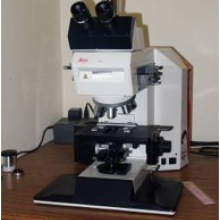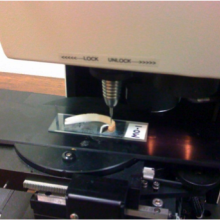Leica DM R Microscope: We received an STF grant to purchase a high-powered microscope with reflected, transmitted, polarized, and filtered light capabilities with a wide range of magnifications (2.5x to 500x). Associated digital imaging equipment projects and captures images for digital preservation of images and software, and software allows for a variety of quantitative analyses. A rotatable petrographic stage and optics for the microscope were added to the setup with an STF grant to allow for additional micromophological analyses. This microscope allows students to perform almost any type of archaeological microanalysis, including wood identification, pollen and starch analysis, use-wear on lithics, geomorphology, and ceramic composition analysis.
Merchantek MicroMill: A micromill was purchased with an STF grant to allow for precision microscopic drilling of various lithic and biogenic materials for isotopic, trace elemental, and radiometric analyses. This allows students to address a variety of paleoclimatic, paleoenvironmental, and geological sourcing questions. For example, shellfish grow incrementally, and by sampling different growth layers within a single specimen can provide data on changes in the local climatic conditions that may provide insight in human-environment interactions. Teeth from some animals like deer likewise have incremental growth, and sampling within each of these may provide migration histories for the individual. Research like this requires samples of very small size, often less than .3mg, taken from very precise locations. It is affixed with a binocular microscope, video/photo capabilities, and carbide steel drilling mechanisms, as well as the necessary peripheral items, software, and computer hardware necessary for sampling operations.
Additional Equipment: The Microanalysis Lab also has a dedicated Sartorius SE2 Ultra Micro microgram scale with a precision of 1.0 micrograms or less, and a Sartorius milligram scale attached to a PC workstation for capturing live data. This has been used with the above equipment for a variety of isotopic and residue analysis.
Example Research: Projects that have used this equipment include identification of firewood species used by prehistoric populations in Alaska, examination of microstructure of shellfish as a proxy for past climatic conditions, determining sources of temper added to ceramics by Southeast Asian potters, and identification of starch granules to identify camas use in the Pacific Northwest.



